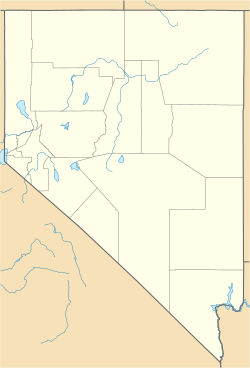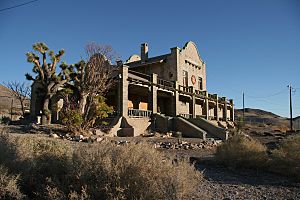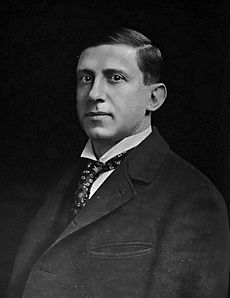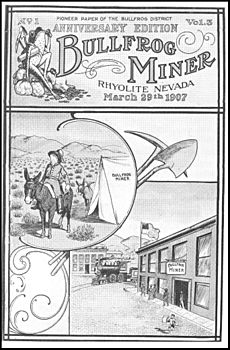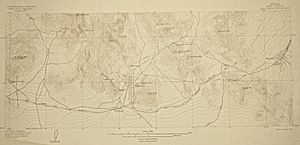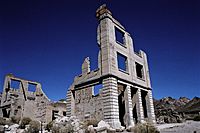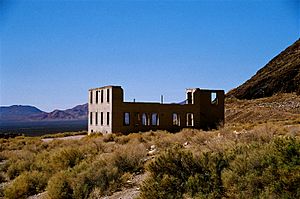Rhyolite, Nevada facts for kids
Quick facts for kids
Rhyolite
|
|
|---|---|
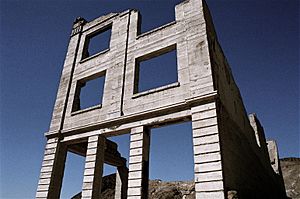
Ruins of the Cook Bank building in Rhyolite, Nevada
|
|
| Etymology: rhyolite, a type of volcanic rock | |
| Country | United States |
| State | Nevada |
| County | Nye |
| Elevation | 3,819 ft (1,164 m) |
| Population
(1907–08)
|
|
| • Total | ~ 3,500 to 5,000 |
| Time zone | UTC-8 (Pacific (PST)) |
| • Summer (DST) | UTC-7 (PDT) |
Rhyolite is a famous ghost town located in Nye County, Nevada, in the United States. It sits in the Bullfrog Hills, about 120 miles (190 km) northwest of Las Vegas. It is also very close to the eastern edge of Death Valley National Park.
Rhyolite started in early 1905. It was one of many mining camps that appeared after gold was found in the nearby hills. During the exciting gold rush, thousands of people came to the Bullfrog Mining District. These included gold-seekers, builders, miners, and people offering services. Many of them settled in Rhyolite. The town was in a safe desert area, close to the biggest gold producer, the Montgomery Shoshone Mine.
In 1906, a rich businessman named Charles M. Schwab bought the Montgomery Shoshone Mine. He spent a lot of money to build important things like water pipes, electric lines, and railroads. These helped both the town and the mine. By 1907, Rhyolite had electric lights, running water, telephones, newspapers, a hospital, a school, an opera house, and even a stock exchange. At its busiest, between 1907 and 1908, Rhyolite had between 3,500 and 5,000 people.
However, Rhyolite's success did not last long. The town quickly declined, just as fast as it grew. The richest gold ore was used up, and production dropped. Big events like the 1906 San Francisco earthquake and a money crisis in 1907 made it harder to get money for new projects. In 1908, investors in the Montgomery Shoshone Mine worried it was not worth as much as they thought. They asked for an independent study. When the study showed bad results, the company's stock value crashed. This made it even harder to get money. By the end of 1910, the mine was losing money, and it closed in 1911. Many miners had already left to find work elsewhere. Rhyolite's population fell to less than 1,000. By 1920, almost no one lived there.
After 1920, Rhyolite and its old buildings became a popular place for tourists. It was also used as a setting for movies. Most of its buildings fell apart, were taken apart for building materials, or were moved to nearby Beatty or other towns. However, the old railway depot and a unique house made of empty bottles were fixed up and saved. From 1988 to 1998, three companies ran a successful open-pit mine near Rhyolite. The Goldwell Open Air Museum, a place with outdoor sculptures, is just south of the ghost town. The ghost town itself is managed by the Bureau of Land Management.
What's in a Name?
The town of Rhyolite gets its name from a type of rock called rhyolite. This is a light-colored igneous rock that is often pink or light gray. It's similar to granite but not as common. The Amargosa River, which flows near Beatty, is named from a Spanish word meaning "bitter." This is because the river picks up a lot of salts, making its water taste bitter.
The name "Bullfrog" came from Frank "Shorty" Harris and Ernest "Ed" Cross. They were the gold prospectors who started the Bullfrog gold rush. They named their mine "Bullfrog" because, as Harris said, "The rock was green, almost like turquoise, spotted with big chunks of yellow metal, and looked a lot like the back of a frog." Many places in the area, like the Bullfrog Mining District and the Bullfrog Hills, got their names from this mine.
The name "Bullfrog" was so popular that many mining companies included it in their names. For example, there were companies like Giant Bullfrog and Bullfrog Gold Dollar. Decades later, a short-lived county was even named Bullfrog County.
Beatty is named after Montillus Murray Beatty, a Civil War veteran and miner. He bought a ranch near the Amargosa River. Later, in 1906, he sold his ranch to a power company. The "Shoshone" in "Montgomery Shoshone Mine" refers to the Western Shoshone people. They are a Native American group who lived in this area. Around 1875, the Shoshone had several camps along the Amargosa River near Beatty. They gathered seeds, bulbs, and plants for food.
Where is Rhyolite Located?
Rhyolite is in the northern part of the Amargosa Desert in Nye County, Nevada. It's tucked away in the Bullfrog Hills. The town is about 120 miles (190 km) northwest of Las Vegas. It's also about 60 miles (97 km) south of Goldfield and 90 miles (140 km) south of Tonopah. The town of Beatty and the Amargosa River are about 4 miles (6.4 km) to the east. To the west, about 5 miles (8.0 km) from Rhyolite, are the Funeral and Grapevine Mountains. These mountains separate the Amargosa Desert from Death Valley in California.
State Route 374 passes about 0.75 miles (1.21 km) south of Rhyolite. This road connects Beatty to Death Valley. Rhyolite is also about 25 miles (40 km) west of Yucca Mountain. This mountain was once considered a site for storing nuclear waste.
Rhyolite is about 3,800 feet (1,200 m) above sea level. It is surrounded by ridges on three sides, but it is open to the south. The highest points around it are Ladd Mountain to the east, Sutherland Mountain to the west, and Busch Peak to the north. Sawtooth Mountain, the tallest point in the Bullfrog Hills, is about 3 miles (4.8 km) northwest of Rhyolite. It rises to 6,002 feet (1,829 m) above sea level.
Nevada's weather is usually sunny and dry. It gets little rain each year, but the higher mountains get heavy snowfall. The air is clean and dry, and temperatures can change a lot between day and night. Even on hot days, the nights are usually cool. Southern Nevada gets sunshine more than 80 percent of the time.
Beatty, which is lower than Rhyolite, gets only about 6 inches (150 mm) of rain a year. July is the hottest month in Beatty, with average high temperatures around 97 °F (36 °C). December and January are the coolest months, with average highs around 54 °F (12 °C). Rhyolite, being higher in the hills, has cooler summers and mild winters. However, it is far from sources of water.
The Rise and Fall of Rhyolite
How Rhyolite Began
On August 9, 1904, two prospectors, Cross and Harris, found gold on a hill in southwestern Nevada. This hill was later called Bullfrog Mountain. Tests of the gold ore showed it was worth a lot of money, up to $3,000 per ton. That would be like over $100,000 per ton in today's money! When news of this discovery spread, thousands of hopeful prospectors and investors rushed to the Bullfrog Mining District.
Rhyolite quickly became the biggest settlement in the district. It grew near the most promising gold find, the Montgomery Shoshone Mine. In February 1905, this mine produced gold ore worth as much as $16,000 per ton. Rhyolite started as a small camp with just two men in January 1905. In just two weeks, it grew to 1,200 people. By June 1905, its population reached 2,500. By then, it had 50 saloons, 35 gambling tables, 19 lodging houses, 16 restaurants, barbers, a public bath house, and a weekly newspaper called the Rhyolite Herald.
Four stage coaches traveled daily between Goldfield, 60 miles (97 km) north, and Rhyolite. There were also car services that took people between Rhyolite, Goldfield, and the train station in Las Vegas.
Growth and Development
Ernest Alexander "Bob" Montgomery, the first owner of the mine, sold it to the wealthy businessman Charles M. Schwab in February 1906. Schwab greatly expanded the mine. He hired many workers, opened new tunnels, and built a huge mill to process the gold ore. He also arranged for water to be piped into the town. He paid to have an electric line built 100 miles (160 km) from a power plant in the Sierras to Rhyolite. He also made a deal with the Las Vegas and Tonopah Railroad to build a special train line to the mine.
Eventually, three different railroads served Rhyolite. The first, the Las Vegas and Tonopah Railroad (LVTR), started regular trains on December 14, 1906. Its train station, built in a California-mission style, cost about $130,000. This would be like millions of dollars today. About six months later, the Bullfrog Goldfield Railroad (BGR) started service from the north. By December 1907, the Tonopah and Tidewater Railroad (TTR) also began service to Rhyolite. The TTR was built to reach areas with borax (a mineral) in Death Valley, as well as the gold fields.
By 1907, Rhyolite had about 4,000 people. Some estimates even say it reached 5,000 people between 1907 and 1908. However, it's hard to know the exact numbers from that time. Newspapers in Rhyolite claimed the town itself had no more than 3,500 people. They estimated that 6,000 people lived in the entire Bullfrog mining district, which included Rhyolite, Bullfrog, Gold Center, and Beatty.
In 1907, Rhyolite was a modern town. It had concrete sidewalks, electric lights, water pipes, telephone and telegraph lines, and daily newspapers. It also had police and fire departments, a hospital, a school, and a train station. There were at least three banks, a stock exchange, an opera house, a public swimming pool, and two church buildings.
The most impressive building was the three-story John S. Cook and Co. Bank on Golden Street. It was finished in 1908 and cost over $90,000. This was a huge amount of money then. Much of the cost went into fancy Italian marble stairs and imported stained-glass windows. This building also held offices for brokers and a post office. Other large buildings included the train depot, the three-story Overbury Block, and the two-story, eight-room school. A miner named Tom T. Kelly built the famous Bottle House in February 1906. He made it from 50,000 empty beer and liquor bottles.
The Rhyolite Mining Stock Exchange opened on March 25, 1907. It had 125 members, including brokers from big cities like New York and Los Angeles. This small office listed shares for 74 Bullfrog companies and many others from nearby mining areas. On the first day, 60,000 shares were traded. By the end of the second week, over 750,000 shares had been traded.
The Decline of Rhyolite
Even though the mine produced over $1 million in gold in its first three years, its stock shares dropped from $23 to less than $3. In February 1908, some investors thought the mine was worth too much. They hired a British mining engineer to check it. His report was not good, and this news caused the share value to drop even more, from $3 to just 75 cents. Charles Schwab, who owned the mine, was disappointed. He learned that the "wonderful high-grade [ore]" that made the mine famous was only in small areas. He had actually bought a large mine with low-grade gold.
Even though the mine was still making some money, no new gold was being found by 1909. The value of the remaining gold kept going down. In 1910, the mine lost money for most of the year. On March 14, 1911, it finally closed. By then, the stock, which had fallen to 10 cents a share, dropped to 4 cents and was removed from the stock exchanges.
Rhyolite started to decline even before the mine fully closed. Around the same time, the 1906 San Francisco earthquake caused money to be sent to California. It also stopped train service. Then, a financial crisis in 1907 made it hard to get money for mine development. As mines in the area produced less or closed, unemployed miners left Rhyolite to find work elsewhere. Businesses failed. By 1910, the census showed only 675 people living there. All three banks in town closed by March 1910. The newspapers, including the Rhyolite Herald, all shut down by June 1912. The post office closed in November 1913. The last train left Rhyolite Station in July 1914. The power company turned off the electricity and removed its lines in 1916. Within a year, the town was "all but abandoned." The 1920 census reported only 14 people. A 1922 car tour by the Los Angeles Times found only one person left, a 92-year-old man who died in 1924.
Much of Rhyolite's remaining buildings were used as materials for other towns. Whole buildings were moved to Beatty. The Miners' Union Hall in Rhyolite became the Old Town Hall in Beatty. Small two-room cabins were moved and put back together as larger homes. Parts of many buildings were used to build a school in Beatty.
Rhyolite Today: A Ghost Town
The historic townsite of Rhyolite is now managed by the Bureau of Land Management. It is known as "one of the most photographed ghost towns in the West." You can still see the ruins of the railroad depot and other buildings. The famous Bottle House was even fixed up in 1925 for a silent movie called The Air Mail. The ruins of the Cook Bank Building were used in the 1964 film The Reward and again in 2004 for The Island. Other movies like Cherry 2000 (1987) and Six-String Samurai (1998) also used Rhyolite as a setting. The Rhyolite-Bullfrog cemetery, with many wooden grave markers, is just south of the town.
Tourism grew in and near Death Valley in the 1920s. People selling souvenirs set up tables in Rhyolite on weekends. In the 1930s, a company in Beatty opened a gas station and supplied pumps in other places, including Rhyolite. The Rhyolite gas station was unique. It used an old caboose, a storage tank, and a pump. In 1937, the train depot became a casino and bar called the Rhyolite Ghost Casino. Later, it was turned into a small museum and gift shop that stayed open until the 1970s. In 1984, a Belgian artist named Albert Szukalski created his sculpture The Last Supper on Golden Street near the Rhyolite railway depot. This art piece became part of the Goldwell Open Air Museum, an outdoor sculpture park near the ghost town.
The Barrick Bullfrog Mine
After 1920, mining in Rhyolite mostly involved working on old mine waste. However, a new mine opened in 1988 on the south side of Ladd Mountain. A company called Bond Gold built an open-pit mine and a mill there, about 1 mile (1.6 km) south of Rhyolite. Another company, LAC Minerals, bought the mine in 1989. They started an underground mine in 1991 after finding a new area of gold ore. Barrick Gold then bought LAC Minerals in 1994 and continued to mine and process gold at what became known as the Barrick Bullfrog Mine until the end of 1998.
The mine used a chemical process called vat leaching. This involved using a weak cyanide solution to get the gold out of the ore. This method made it possible to get gold profitably even from lower-quality ore. During its time, the mine processed about 2.8 million short tons (2.5 million metric tons) of ore. It produced about 690,000 ounces (20,000 kg) of gold.
Images for kids
See also
 In Spanish: Rhyolite (despoblado) para niños
In Spanish: Rhyolite (despoblado) para niños


